Wine Spotlight: Zesty Elegance – South African Sauvignon Blanc Brilliance
Interested in making South African Sauvignon Blanc? Give us a call at 877-812-1137 to speak to a winemaking representative about your order. Cheers!
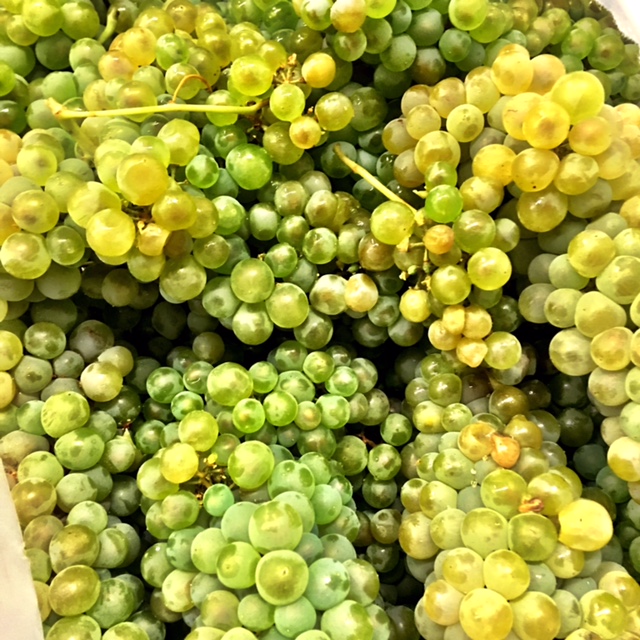
Appearance:
In the glass, South African Sauvignon Blanc presents a pale straw color with a hint of green, reflecting its youthful and vibrant nature. Its clarity and brilliance invite anticipation for the refreshing experience that lies ahead.
Aroma:
A symphony of citrus and tropical fruit aromas greets the nose, revealing the varietal’s signature characteristics. Notes of zesty lime, ripe grapefruit, and a touch of passion fruit dance harmoniously, creating an enticing bouquet. The aroma is clean, bright, and promises a burst of freshness with each sip. (yeast suggestion: R2, 71B, QA23, VIN13)
Palate:
As the wine touches the palate, it delivers a burst of invigorating flavors. Crisp green apple and lively pineapple take center stage, accompanied by hints of freshly cut grass and a subtle herbal undertone. The wine’s vibrant acidity adds a refreshing zing, creating a palate-cleansing sensation that lingers into a clean, lingering finish.
Flavor Profile:
This Sauvignon Blanc is a true expression of South Africa’s wine region terroir. The fruit-forward profile is complemented by a minerality that adds depth and complexity. The judicious use of stainless steel and glass in winemaking allows the purity of the fruit to shine, resulting in a wine that is both lively and elegant.
Pairing Suggestions:
The bright acidity and crispness of this Sauvignon Blanc make it an ideal companion for a variety of dishes. Pair it with fresh seafood, goat cheese salads, or herb-infused chicken for a delightful culinary experience. Alternatively, enjoy it on its own as a refreshing aperitif on a warm day.
Overall Impression:
South African Sauvignon Blanc is a testament to the region’s ability to craft wines that balance freshness and flavor. It captures the essence of the grape with precision, offering a sensory journey that captures the spirit of South Africa.
Interested in making South African Sauvignon Blanc? Give us a call at 877-812-1137 to speak to a winemaking representative about your order. Cheers!
Hurry! Get Your Spring Orders In Before It’s Too Late!
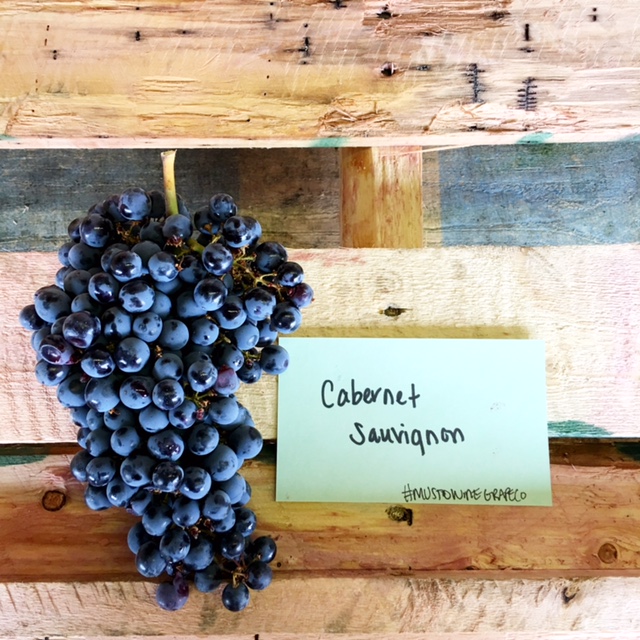
Dear Valued Winemakers,
We hope this post finds you well and excited about the fantastic Spring products we have in store for you! As we gear up for another exciting week, we wanted to remind you that time is ticking, and we don’t want you to miss out on the opportunity to get your hands on our amazing Spring offerings.
From South Africa:
Juice Varieties: Shiraz, Merlot, Pinotage, Cabernet Sauvignon, Semillon, Chardonnay, Pinot Grigio, Chenin Blanc, Sauvignon Blanc
Fresco Juice Varieties: Cabernet Sauvignon, Pinotage, Shiraz, Sauvignon Blanc
Arrivals: Last week in April
From Chile:
Grapes Varieties: Carmenere, Cabernet Sauvignon, Cabernet Franc, Malbec, Merlot, Petite Verdot, Pinot Noir, Syrah, Chardonnay, Pinot Grigio, Sauvignon Blanc, and Viognier
Juice Varieties: Carmenere, Cabernet Sauvignon, Cabernet Franc, Cabernet/Merlot Blend, Malbec, Merlot, Petite Verdot, Pinot Noir, Syrah, Chardonnay, Pinot Grigio, Sauvignon Blanc, and Viognier.
Fresco Juice Varieties: Cabernet Sauvignon, Carmenere, Malbec, Merlot, Chardonnay, Chardonnay-Semillon, Sauvignon Blanc, Viognier
Arrivals: First week in May
Whether you’re looking for that perfect blending wine, treating yourself to something special, or simply stocking up on your favorite variety, now is the time to act! Our boats will be arriving soon and they are brimming with top-quality products waiting to be discovered. We wouldn’t want you to miss out on the fun of Spring winemaking. Don’t let procrastination steal your joy – place your order today and let the anticipation begin!
So, what are you waiting for? Join the excitement, and let’s make this Spring winemaking experience one to remember!
Thank you for choosing Musto Wine Grape Co. We truly appreciate your continued support.
Happy Winemaking!
Warmest Regards,
The Musto Crush Crew
877-812-1137
Unveiling the Artistry Behind Chilean Wine: A Toast to Excellence
In the world of winemaking, few regions can boast the combination of unique terroir, skilled artisans, and a rich cultural history quite like Chile. Nestled between the Andes Mountains and the Pacific Ocean, this South American gem has been quietly gaining recognition as a powerhouse in the global wine industry. Let’s embark on a journey to discover why making Chilean wine is nothing short of an art form.
The Terroir Advantage:
Chile’s diverse geography, ranging from the arid Atacama Desert to the cool, maritime-influenced climate of the coastal areas, provides winemakers with a canvas of terroirs. The result is a wide spectrum of flavors and aromas that make Chilean wines unique. From the robust reds of Curico Valle, each sip reflects the character of its terroir.
Sustainable Practices:
Chilean winemakers have embraced sustainable and organic practices, aligning their craft with environmental consciousness. Many vineyards prioritize biodiversity, water conservation, and minimal chemical intervention. This commitment not only preserves the pristine landscapes but also enhances the purity and authenticity of the wines produced.
Iconic Grape Varieties:
Chilean winemaking is defined by its dedication to traditional grape varieties, with a particular focus on Carmenere, often referred to as Chile’s signature grape. This once-forgotten Bordeaux varietal found its new home in Chile, producing wines with luscious dark fruit flavors and a distinct spiciness. Cabernet Sauvignon, Merlot, and Sauvignon Blanc also thrive in the fertile soils, contributing to the country’s diverse wine portfolio.
Innovation and Modern Techniques:
While honoring tradition, Chilean winemakers are not afraid to embrace innovation. State-of-the-art winemaking facilities equipped with modern technology allow for precise control over the winemaking process. This fusion of tradition and innovation ensures the consistency and quality of Chilean wines, earning them accolades on the international stage.
In the world of winemaking, Chile stands as a testament to the perfect marriage of nature’s gifts and human craftsmanship. The artistry behind making Chilean wine is a celebration of terroir, sustainability, iconic grape varieties, and a commitment to excellence. So, the next time you uncork a bottle of Chilean wine, savor not just the liquid in the glass but the story of a nation passionate about producing wines that captivate the senses.
Interested in making South African or Chilean Wine? Give us a call at 877-812-1137 to speak to a winemaking representative about your order. Cheers!
Chilean Wine Notes
Why make wine from Chile? Because it’s like bottling up sunshine and smiles!
Picture this: rolling vineyards nestled between the Andes Mountains and the Pacific Ocean, where grapes bask in the perfect blend of cool coastal breezes and warm, sunny days. Chile’s diverse terroir makes it a winemaker’s paradise, offering a kaleidoscope of flavors just waiting to be uncorked.
CHILEAN WINE NOTES
Cabernet Sauvignon:
A flagship for Chile, their Cabernet Sauvignon impresses with its deep ruby color and complex aromas of blackcurrant, cherry, cedar, and tobacco. On the palate, it’s rich and full-bodied, with well-integrated tannins and a long, lingering finish.
Cabernet Franc:
Cabernet Franc from Chile offers an elegant expression of the varietal. With aromas of red berries, violet, and herbs, it’s vibrant and aromatic. On the palate, it’s medium-bodied with silky tannins and a fresh, persistent finish.
Carmenere:
Chilean Carmenere showcases the best of Chile’s signature grape. With deep purple color and aromas of blackberry, plum, and spices, it’s captivating. Lush and velvety on the palate, with flavors of ripe fruit, chocolate, and a touch of smokiness.
Malbec:
A standout example of great winemaking grapes, the Chilean Malbec boasts intense aromas of blackberry, plum, and violet, with hints of vanilla and spice. On the palate, it’s full-bodied and expressive, with ripe tannins and a long, smooth finish.
Merlot:
Chilean Merlot offers aromas of ripe plum, cherry, and spices, with subtle hints of chocolate and vanilla. Medium-bodied and smooth on the palate, with soft tannins and a lingering finish.
Pinot Noir:
The Chilean Coastal Pinot Noir exhibits delicate aromas of red fruits, flowers, and earthy notes. Light-bodied and elegant, with vibrant acidity and silky tannins, it’s a perfect expression of Chilean terroir.
Syrah:
Syrah from Chile showcases the richness and depth. With aromas of blackberry, blueberry, and pepper, it’s intense and alluring. Full-bodied and velvety on the palate, with layers of dark fruit, spice, and a long, lingering finish.
Chardonnay:
From the cool-climate region of Chile, Chardonnay offers aromas of tropical fruits, citrus, and vanilla. Medium to full-bodied, with a creamy texture and balanced acidity, it’s a delightful expression of Chilean Chardonnay.
Pinot Grigio:
Pinot Gris from Chile showcases fresh aromas of green apple, pear, and citrus, with floral undertones. Crisp and refreshing on the palate, with lively acidity and a clean, mineral-driven finish.
Sauvignon Blanc:
Chilean Sauvignon Blanc has aromas of grapefruit, lime, and herbs. Crisp and vibrant on the palate, with zesty acidity and a refreshing finish.
Viognier:
Viognier from Chile displays enticing aromas of apricot, peach, and orange blossom, with hints of honey and spice. Medium-bodied and luscious on the palate, with a smooth, lingering finish.
Interested in making Chilean Wines? We have the grapes and juices! Give us a call at 877-812-1137 to speak to a winemaking representative about your order. Cheers!
Cheers to Spring Winemaking Adventures!
Hey there, fellow vintners and grape aficionados,
As the frost thaws and the vines awaken from their winter slumber, can you feel that excitement bubbling up like a well-aged Cab Sauv? That’s right, it’s time to dust off those barrels, polish those glasses, and get ready to dive headfirst into the spring winemaking season!
Whether you’re dreaming of crisp Chardonnays, robust Merlots, or something in between, now’s the time to get those orders in. From grapes, juices, fermenting tanks, corks, and everything in between, we’ve got you covered. So, why wait? Let’s uncork the magic of spring together!
2024 Spring Grape Offerings:
Chile: Cabernet Sauvignon, Cabernet Franc, Carmenere, Malbec, Merlot, Petite Verdot, Pinot Noir, Syrah, Chardonnay, Pinot Grigio, Sauvignon Blanc, and Viognier
2024 Spring Juice Offerings:
South Africa: Shiraz, Merlot, Pinotage, Cabernet Sauvignon, Semillon, Chardonnay, Pinot Grigio, Chenin Blanc, and Sauvignon Blanc.
Chile: Cabernet Sauvignon, Cabernet Franc, Carmenere, Malbec, Merlot, Petite Verdot, Pinot Noir, Syrah, Chardonnay, Pinot Grigio, Sauvignon Blanc, Viognier, and Muscat.
Crush/Destemm will be back!
We will be crushing and destemming again this year! However, there is a minimum order of 24 cases of Spring grapes. This will give you 6 pails of must, and about 20+ gallons of juice to work with.
Winemaking Classes:
Check out Musto Wine Grape & Frank Renaldi’s online classes via our sister site WinemakingInstructions.com.
Winemaker Hours:
Winemaker Sam Lee will be in the store and available for questions on Tuesdays and Fridays from 8:00AM-4:00PM. If you want to speak to a winemaker in person, make sure to stop by and see Sam! You can also email him at slee@juicegrape.com.
March Store Hours:
Mon-Fri: 8:00AM-4:00PM
Sat-Sun: Closed
Ready to take your winemaking to new heights? Simply shoot us an email or give us a call, and we’ll make sure you’re all set to rock this winemaking season.
Here’s to the grape adventures ahead!
What is Cold Soaking?
Cold soaking, also known as pre-fermentation maceration, is a winemaking technique that is widely used in the production of red wines. It involves holding crushed red grapes at a low temperature and takes place before fermentation.
Why should I be cold soaking?
Cold soaking red grapes such as Pinot Noir, Cabernet Sauvignon, Merlot, and more has many benefits. The aim of a cold soak is to extract more aromas, aroma intensity, and color from the skins of the grapes. In red wines, it makes for a more intensely fruity and deeper-colored wine; but it also makes for a fuller wine with increased palate weight. For example, in Pinot Noir, cold-soaking extracts the softer, more supple tannins to help produce a silky mouthfeel. It also helps emphasize the lush fruit notes like dark cherry and plum. Yum!
But wait; there’s more: Firstly, time in a cold soak, even a brief one, lets a winemaker get a much better handle on the fruit at hand, enough time to get a tank thoroughly mixed, time for any raisins in the fruit to reveal their sugars, time to get more trustworthy readings on basic wine chemistry than the numbers grabbed in the rush of fruit delivery. And second, extracting some goodies early in the cycle leaves open the option of pressing slightly early and working off the last few Brix in barrel, again minimizing the influence of nasty seed tannin.
How do I do it?
It is important to maintain a chilled temperature because if the must gets too warm it can begin fermenting. To properly cold soak, you need to maintain a temperature of about 35-45 degrees Fahrenheit. This could be difficult for home winemakers without a chiller system. Try using dry ice or ice tubes ser in the wine to the wine as cold as you can. Remember, the point of the low temperature is to be sure the yeast cannot get started.
This is usually done for about 5 days, though the length of time varies according to the winemaker’s goals and the grape variety. You should add enzymes to help the extraction move along, and sulfur dioxide to inhibit unwanted microbial activity. Using inert gas to prevent oxidation is also a great idea. Inert gases, known as carbon dioxide, nitrogen, and argon are necessary for winemaking. They are used to supplant air in places where air could come into contact with the wine.
Need help with cold soaking your grapes?
Musto Wine Grape Company is here to help. Give us a call at (877) 812-1137 to speak with one of Musto’s Crush Crew members. We’re here to provide you with the best quality wine grapes, juices, and equipment, as well as the support to ensure you are successful in making the wine of your dreams!
Wine Spotlight: Amorosso/Amarone Blend
One of our all time favorite Italian wine juices will be arriving in October, the Amorrosso/Amarone Blend. Sweet and bold, this wine is popular at any table. It will be arriving in early October from Italy. The Amarone fresh juice is available for pre-order and on demand pick up. The Amorosso Fresco is pre-order only. Please call 877-812-1137 to put in your order. We have a huge list of Italian wine juices for sale. Be sure to give us a call to check out what is available.
The Blend:
Amorosso/Amarone wine is a unique and highly regarded red wine produced in the Valpolicella region of Veneto, Italy. It is known for its rich, full-bodied flavor, high alcohol content, and complex aroma. Primarily made from three grape varieties: Corvina, Corvinone, and Rondinella. The grapes are carefully selected from well-maintained vineyards, and only the ripest bunches are chosen for this blend.
Appassimento:
The key step in Amarone production is the drying process, also known as “appassimento.” Instead of pressing the grapes immediately, they are spread out on wooden racks or straw mats in well-ventilated rooms, lofts, or drying chambers. During this time, they lose water content, which concentrates their sugars, flavors, and aromas. This process can reduce the weight of the grapes by 30-40%.
After the drying process, the grapes are gently crushed to release their juice. The grape skins are thick and full of flavor due to the drying process.
Winemaking Notes:
Typically, after fermentation, Amorossa/Amarone wine is aged for an extended period in oak barrels. The aging process can range from two to several years, depending on the producer’s preferences. This aging helps mellow the wine’s tannins, integrate its flavors, and develop its complex bouquet. For step by step instructions check out this blog post.
Flavor Profile:
Amorosso/Amarone wine is characterized by its deep ruby-red color, intense and complex aromas of dried fruits, dark cherries, spices, and a full-bodied, velvety texture. It is often enjoyed as a fine wine on its own or paired with hearty dishes like roasted meats, game, and aged cheeses. Due to its unique production method, Amorosso/Amarone tends to be more expensive than many other Italian wines but is highly regarded by wine enthusiasts for its exceptional quality and flavor profile.
Viva Italia!
To make an Italian wine juice order please contact us via sales@juicegrape.com or call us at 877-812-1137, follow us on Facebook, Instagram, and Youtube, or check out the Harvest Tracker and Winemaker Blog on our website- juicegrape.com.
What is the difference between Fresco Juices and Fresh Juices?
What is the difference between Fresco Juice vs. Fresh Juice?
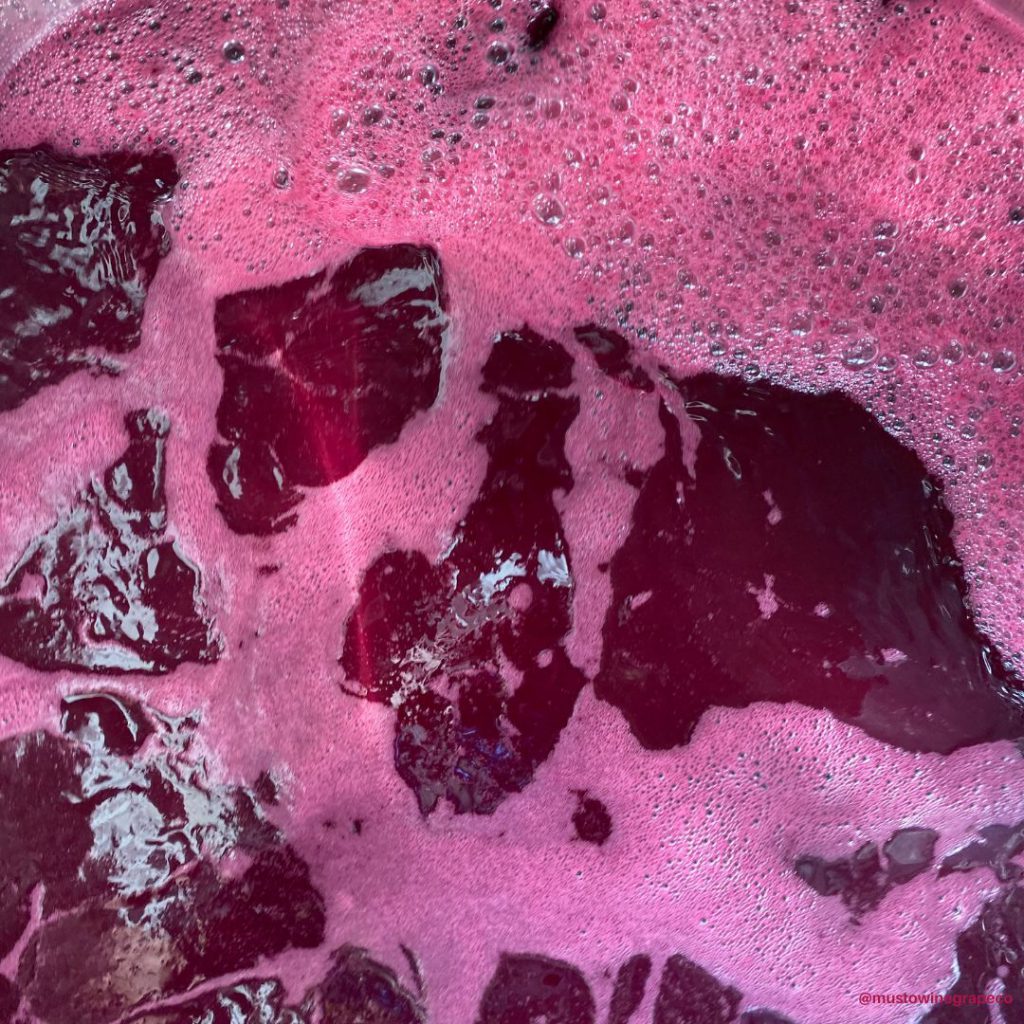
Fresco Juices:
Ever bake a cake from a box and it came out delicious? Did you know you could do the same with winemaking?
Mondiale Fresco is proud to be the only product to offer home winemakers their own vineyard in one unique package. Each pail of juice is pre-balanced and adjusted to ensure you have the best winemaking success possible. Just warm up the juice to fermentation temperature and watch it go.
What does “pre-balanced” and “adjusted” mean?
Every season Mother Nature gives us a different wine grape harvest. Some years the acid, pH, and sugars are all in line with each other. Most times they aren’t and there needs to be some slight adjustments made pre-fermentation to ensure top wine quality. The Fresco juices are adjusted so that the acid, pH, and sugar levels are all in balance with each other. This makes for an easier fermentation and, a very pleasing wine.
Depending on the varietal of wine you choose, enzymes and tannins might be added – all pre-measured, and ready-to-go, just open the packet and add to the pail. These add-ons help with wine clarity and mouthfeel, contributing to the “taste like made from scratch”, or in this case, as if fermented on the skins. The Fresco juices are the best juices to work with for busy winemakers. You get the juice warmed up, watch it ferment, age, and bottle.
Fresh Juices:
Fresh Juices come straight from the press!
Our fresh juices are from the grapes that are crushed, destemmed, and pressed right into the pails. For white wine, this is as if you were crushing and pressing yourself. For red wine the grapes are run through a heat or “hot” press in order to extract the color. Once these pails come up to temperature they can kick off because of the native yeast from the original grapes, or you can kill the native yeast and pitch your own yeast to ensure a more successful fermentation. Either way you are working with the fresh juice, not from concetrate. A delicous wine can be on your table as soon as Christmas!
So what is the difference?
The Fresh Juices are the straight from the press. The Fresco juices are straigth from the press, but pre-balanced and have a few additions made to them to make fermentation easier on the winemaker.
Either way you have delicious wine in the making!
To make an order please contact us via sales@juicegrape.com or call us at 877-812-1137, follow us on Facebook, Instagram, and Youtube, or check out the Harvest Tracker and Winemaker Blog on our website- juicegrape.com.
Upgrade Your Winemaking Juice with the AllGrape Pack!
Upgrade Your Winemaking Juice with the AllGrape Pack!
Making from Fresh Juice or Wine Kits produces a fantastic wine, but can sometimes be lacking in tannins, color, flavor, and mouthfeel. This isn’t the winemaker’s fault, this is becasue these types of product do not get ample time on the grape skins to give the wine that extra kick of complexity.
Lucky for you, We Have a Solution! Enter the AllGrape Pack
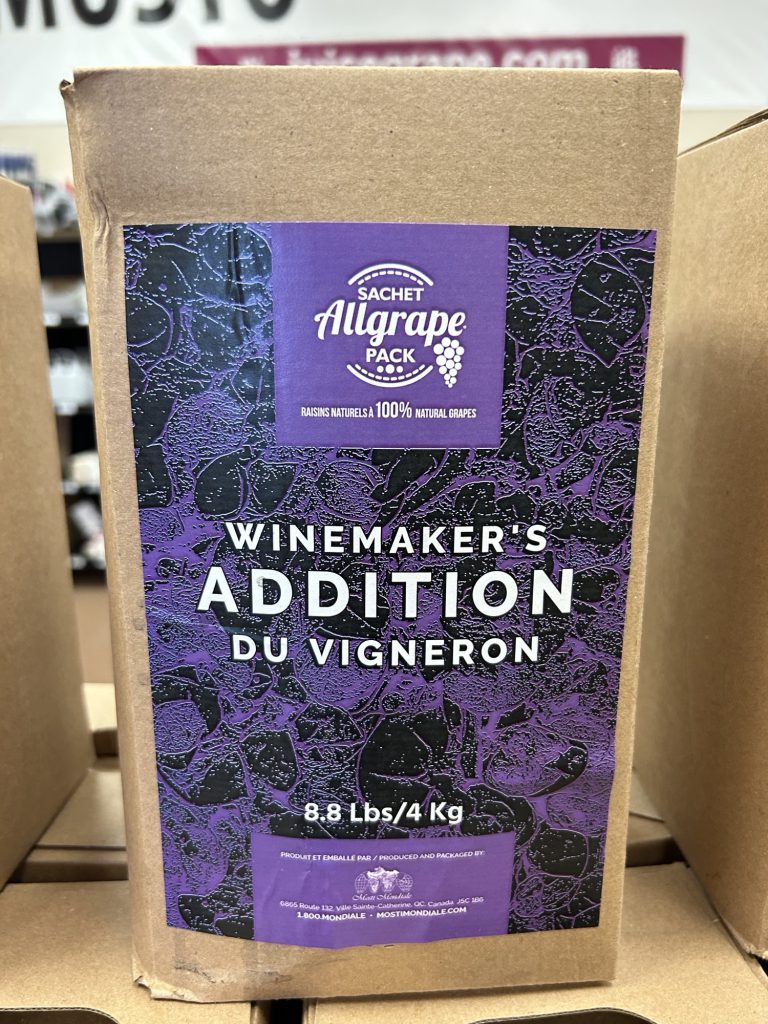
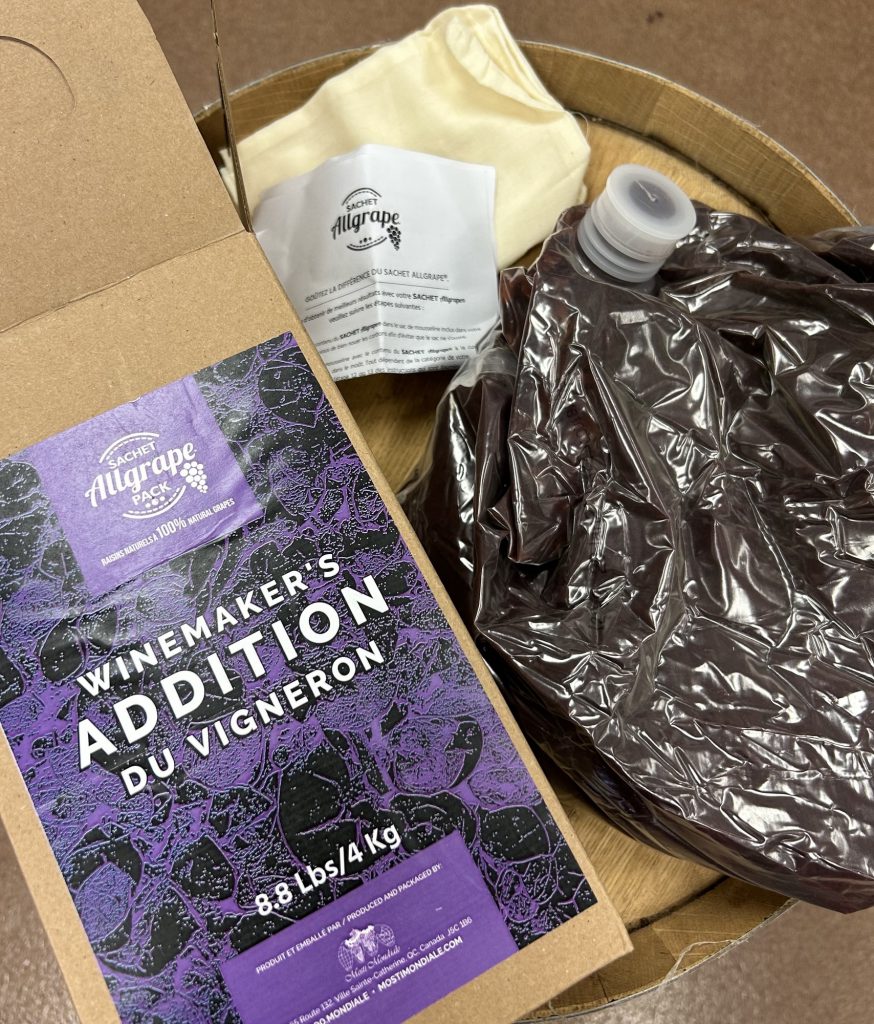






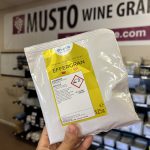
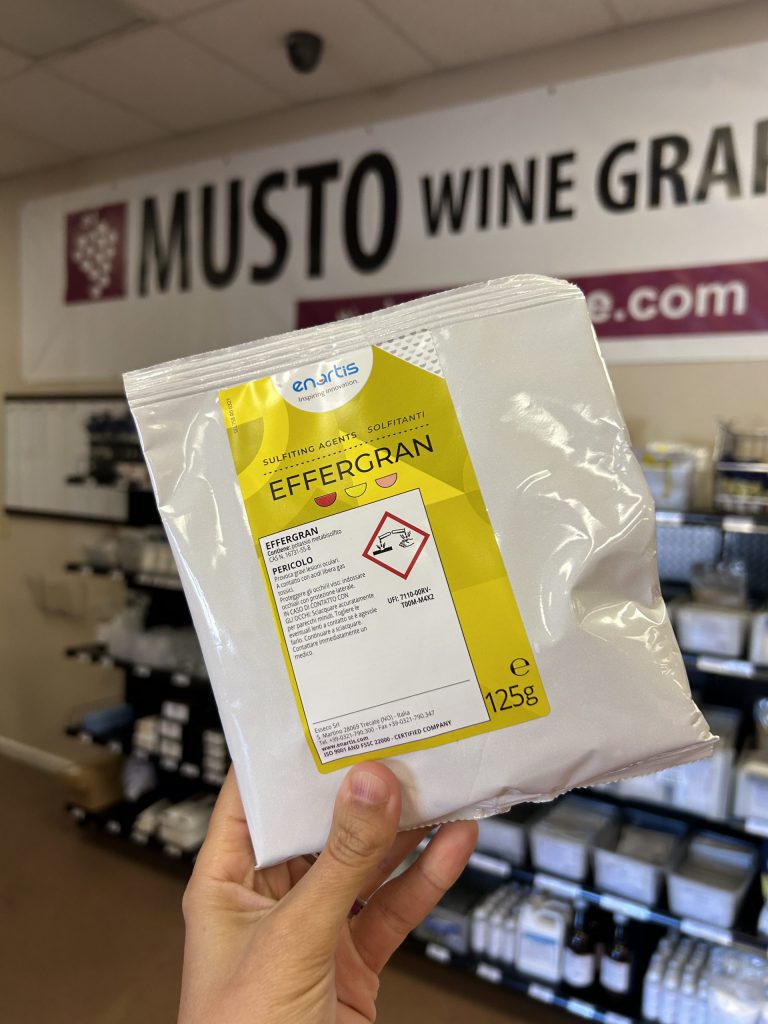
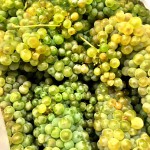
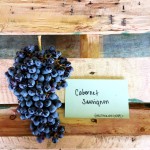
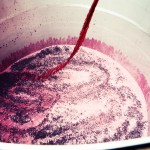
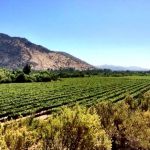
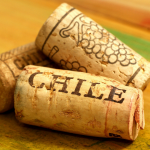
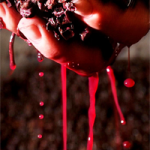
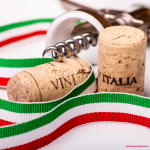
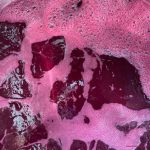
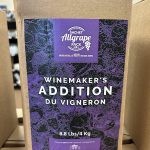
Recent Comments